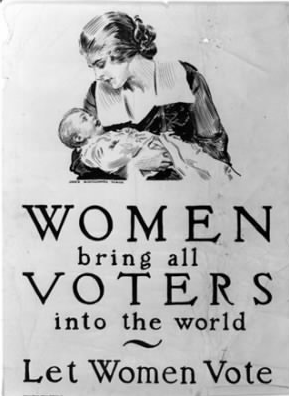Women's Suffrage
Women's Suffrage - The Right to Vote
Summary
Women's Suffrage was the movement that aimed for women to gain the right to vote. The movement began in the early 1800s and was closely tied to the feminist movement. Women lobbied to gain the same rights that men had, including the right to vote, own property, make money as well as many other rights that they were denied solely because they were female.
History
In the early 1800s, white men were the only eligible voters in North America, which angered many people. Women, different races, and First Nations people were barred from voting for the leaders of their countries. Each of these groups had their own campaign to legalize voting. One of the most influential was women. Women around Canada, the United States, and worldwide began to lobby for their right to have a say in the government. Slowly, cities, states, and provinces started allowing women to vote. In 1918 in Canada and 1920 in the United States, Women were finally allowed to vote federally.

Influential Women
The Famous 5
Nellie McClung, Emily Murphy, Henrietta Muir Edwards, Louise Crummy McKinney and Irene Parlby
The five women known as the Famous 5 were women's rights activists in Alberta, Canada. Each of these women made significant contributions to the Canadian political system, specifically when they were involved with the 'Persons Case'. There is a statue on Parliament Hill of the five women, called 'Women Are Persons!'
Emmeline Pankhurst
Emmeline Pankhurst (born Emmeline Goulden) was the founder of the Women's Franchise League in Britain. She founded the group in 1889 to fight for married women's right to vote. Her husband, Richard Pankhurst, was an avid supporter of the suffrage movement and used his status as a lawyer to help Emmeline, eventually writing the Married Women's Property Act, giving married women the right to keep their own property and earnings.
Susan B. Anthony
Susan B. Anthony was an American activist in the mid to late 1800's. She attended her first women's rights convention in 1852 and continued on to found the American Equal Rights Association with Elizabeth Cady Stanton, one of the leaders of the women's rights movement. She went on tours to campaign for women's suffrage and was arrested multiple times. Later on in her life, she became the President of the National American Women Suffrage Association.
Worldwide
New Zealand was the first country in the world to legalize women's suffrage in 1893, while Saudi Arabia was the last, in 2011.
Events and Protests
= The Persons Case
This case was started in 1927 by the 'Famous Five' in order to allow women to run for senate. In 1928 The Supreme Court of Canada ruled that women were not considered as "persons" under the British North American Act and were therefore not allowed to run for senate. The case was taken to the Privy Council of England by the "Famous Five" in 1929 who reversed the Supreme Court's decision. The Persons Case opened opportunities for women to run for parliament and most importantly recognized them as "persons" under the law, therefore qualifying for the same legal rights and protection as men.
Timeline
It is known that women’s suffrage was a long battle with long overdue outcomes. Though the fight for the right to vote was an uphill battle for many years, there was a catalyst that really motivated the final few steps in gaining a law change and the freedom of expression and power for women permanently. Alice Paul was a remarkable figure in the movement and helped lead the Washington parade that changed the women’s suffrage movement from passive to active, her and her supporters being the first group to ever picket the White House, shaking the foundations of male dominance. The jailing of her and her supporters and the abuse they faced in these confinements have been discussed as the changing act that drove the public to finalize the 19th Amendment once and for all. Her mentality was simply lobbying for the equal treatment of men and women, and not to stop only at the achievement of the right to vote, but devoted her life to the cause.
- 1893 - New Zealand women were the first to be given the right to vote
- 1884 - Unmarried and widowed women were given the right to vote municipally in Ontario
- 1916 - Women were given the right to vote provincially in Manitoba
- 1917 - British Women in Canada who were wives, mothers and sisters of soldiers fighting in the First World War could vote federally on behalf of their male relatives.
- 1918 - Women (with the exception of aboriginal and Asian women) could vote federally in Canada
- 1920 - Women could vote federally in the United States
- 2011 - Women in Saudi Arabia were given the right to vote
The Nineteenth Amendment
After much protest and sacrifice, the supporters of Women’s suffrage accomplished their goal when the Nineteenth Amendment to the United States Constitution was ratified on August 18th, 1920. The amendment simply prohibits the exclusion of any United States citizen from being denied the right to vote based on gender. The amendment followed the right to vote in some parts of the world, and helped jumpstart the right to vote in other parts, also extending the movement to other groups in society (such as Aboriginals and other ethnicities excluded from this civility).
The Right to Vote
Women were not the only people for whom the right to vote was not given. African Americans, First Nations people, Asian Americans and others were all seen as non-citizens and also fought for their right to vote.
Links
http://www.ournellie.com/ http://www.cbc.ca/strombo/news/women-the-right-to-vote-in-canada-an-important-clarification.html https://www.nwhm.org/online-exhibits/progressiveera/suffrage.html http://www.thecanadianencyclopedia.ca/en/article/franchise/ https://www.nwhm.org/online-exhibits/rightsforwomen/introduction.html http://www.bbc.co.uk/history/historic_figures/pankhurst_emmeline.shtml http://www.thecanadianencyclopedia.ca/en/article/famous-5/ http://www.thecanadianencyclopedia.ca/en/article/persons-case/ http://www.history.com/topics/womens-history/the-fight-for-womens-suffrage